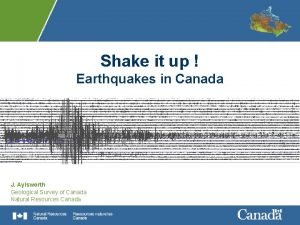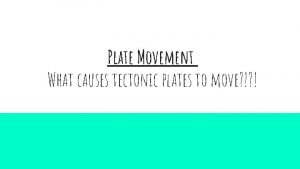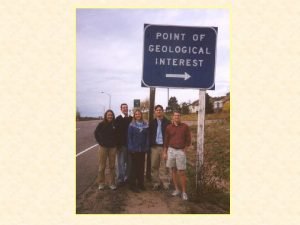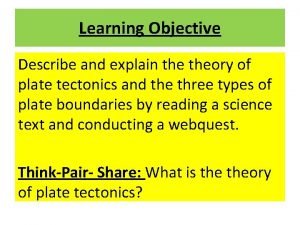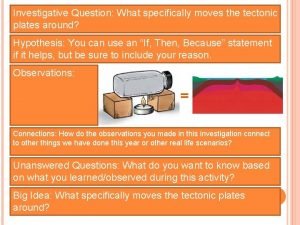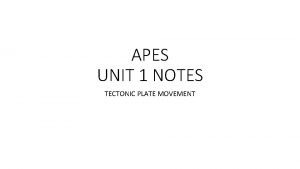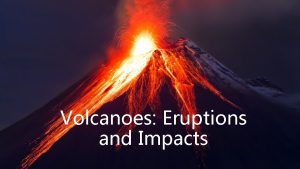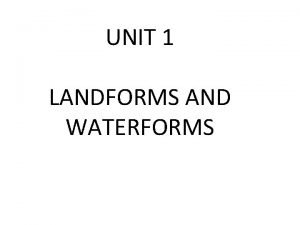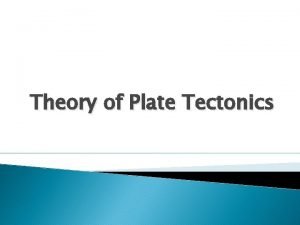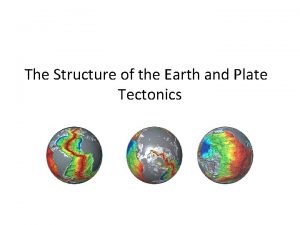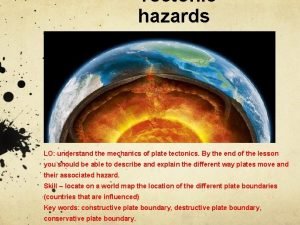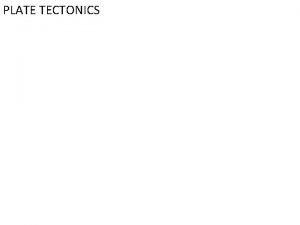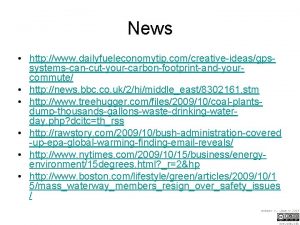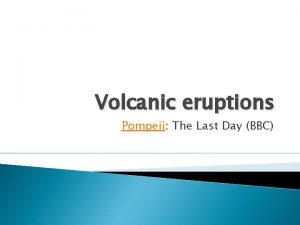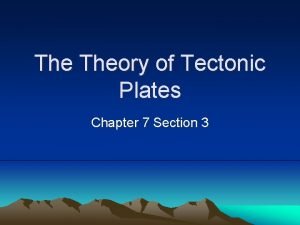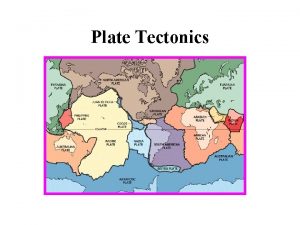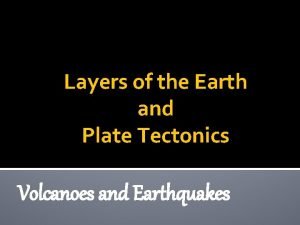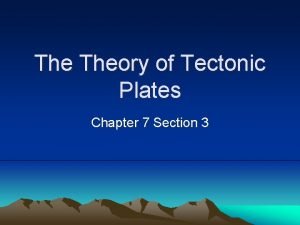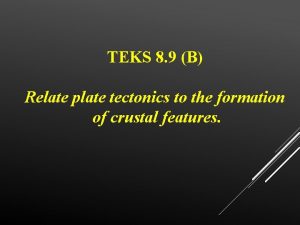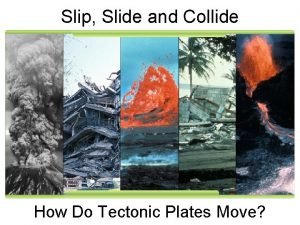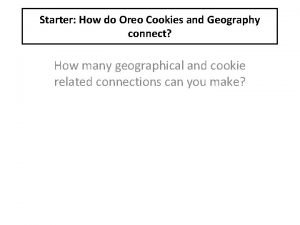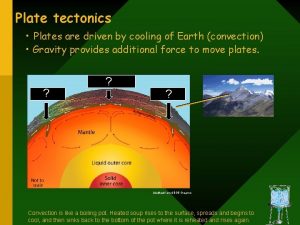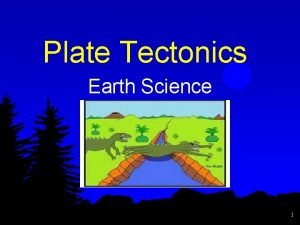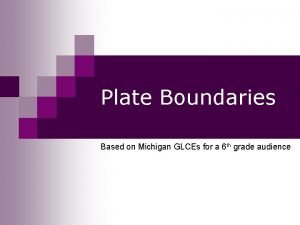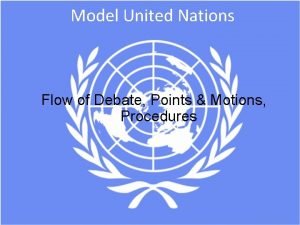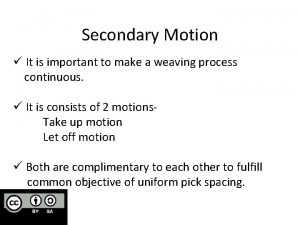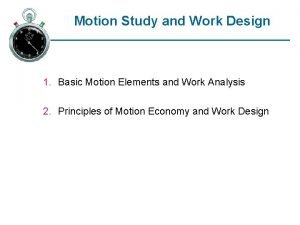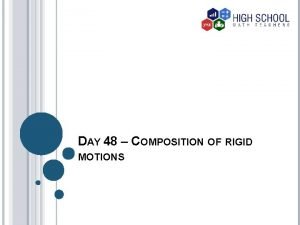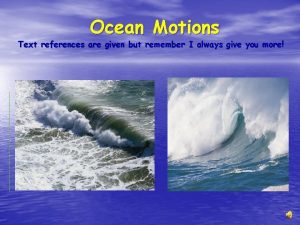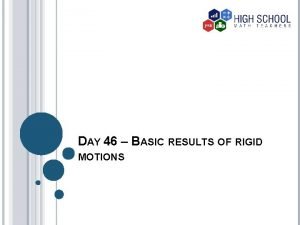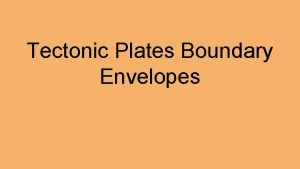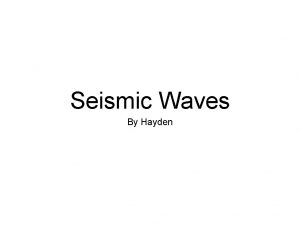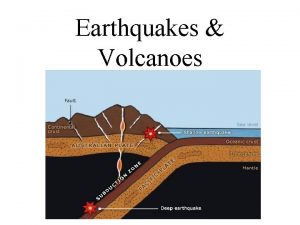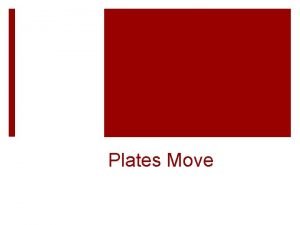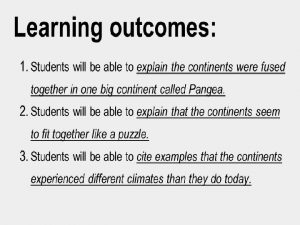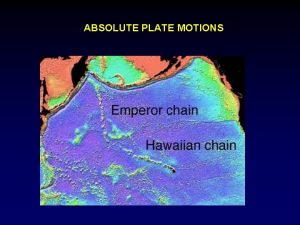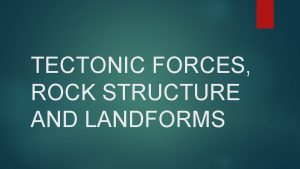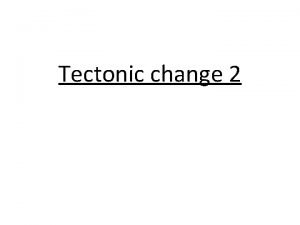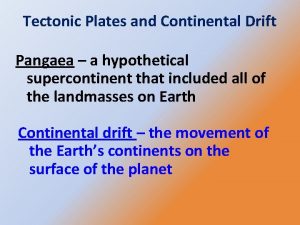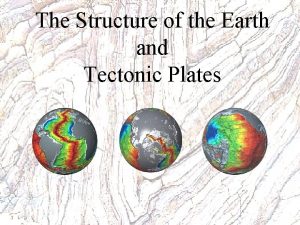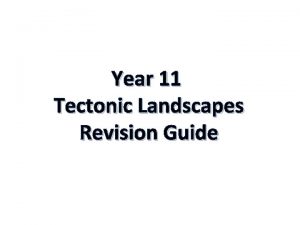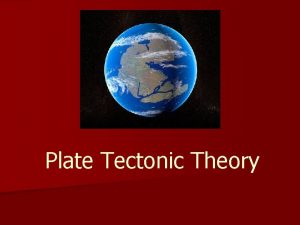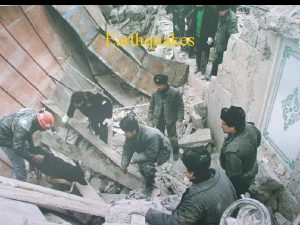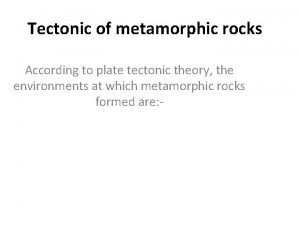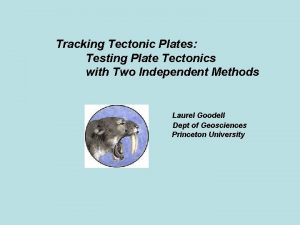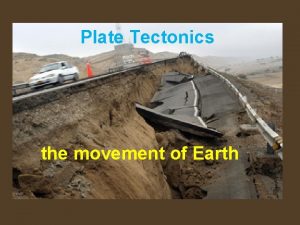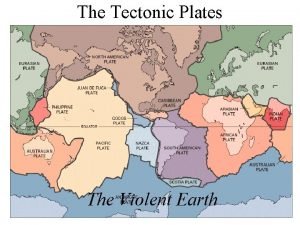Tectonic Plates and Their Motions How did the







































- Slides: 39

Tectonic Plates and Their Motions • How did the idea of continental drift lead to • • • plate tectonics? How do we know that plates move apart at divergent plate boundaries? How do we know that subduction occurs at convergent plate boundaries? How do we know that plates slide past one another at transform plate boundaries? What does the mantle-plume (hot spot) hypothesis explain what plate tectonics cannot? What forces cause plate motions?

How did the idea of continental drift lead to plate tectonics? • Alfred Wegener – Noted matching continental boundaries by shape and geologic features (1912, 1928). Developed the idea of continental drift - continents move over geologic time. • Good evidence for fitting continents together. • However, no good mechanism for movements. Wegener suggested they move like icebreakers through the oceanic crust. This idea was dismissed by most of the geologic community at the time, in fact Wegener was ridiculed! However, it started a search for a mechanism that would explain the motion of the continents.

Continental Drift – The Geologic Evidence Alfred Wegener proposed Continental Drift in 1912 because…. The plants and animals (fossils), the ice, the rocks all match. but the climates and poles do not. The shapes of continents match,

Fig 12. 1 Evidence From The Rocks

Evidence From Fossils

Evidence From Paleoclimate Studies

How did the idea of continental drift lead to plate tectonics? Wegener saw the continents as a giant jigsaw puzzle that fit together into a single continent in the past - Pangea. Fig 11. 2

How do we know that plates move apart at divergent plate boundaries? • Matching the edges of Africa and South America requires three conditions: • A plate containing the two existed before the Atlantic Ocean existed. • That plate split and separated the two continents, producing the Atlantic Ocean. • The Atlantic Ocean grows wider with time. • Plate tectonics predicts that oceanic crust forms where continents separate. Is the geology of the seafloor consistent with this?

How do we know that plates move apart at divergent plate boundaries? A divergent plate boundary: creation of new oceanic crust and lithosphere from the upwelling mafic magmas as the ocean basin opens up by extension. Can we directly observe this happening anywhere on Earth?

How do we know that plates move apart at divergent plate boundaries? Iceland - a mid-ocean ridge is present above sea level. The island is widening at the rate of ~4 mm/year due to the divergent plate boundary.

We know the Earth’s magnetic field has reversed many times in the past. Stacks of lava flows on land record this. If the seafloor spreads at divergent boundaries, the periodic magnetic reversals should be captured in the cooling mafic rocks and carried away on both sides – and rocks should get older away from the spreading center. This was verified by geologists in the 1960 s aboard ships taking magnetic readings.

The magnetic record of ocean crust: The normal and reversed fields are recorded as a set of matched strips on either side of the divergent boundary. Thus, the time periods of Earth’s magnetic intervals is recorded in rock - younger in the center of ocean basins, and older towards the edges. Animation.

How do we know that plates move apart at divergent plate boundaries? Hundreds of isotopic dates on seafloor basalts have confirmed this.

How do we know that plates move apart at divergent plate boundaries? Heat flow data measured on the ocean floor: Midocean ridges are hot areas and heat flow is progressively lower away from the ridge.

Mid-Ocean Ridges are Seismically Slow Areas Due to Heat Mantle tomography – provides images similar to ultrasound.

Movement of GPS Stations GPS station positions change as plates move. Will the position of these stations change relative to one another? Beginning in the early 1990’s GPS stations were set up globally, they now number in the thousands worldwide. We have nearly 20 years of measurements of plate motions.

Continental Rifts Are the Precursors to Ocean Basins When tensional forces act on a continent, rift valleys form.

Continental Rifts Are the Precursors to Ocean Basins With time the rift widens, mafic crust forms, it is covered with eroding sediment, and sinks into the asthenosphere due to its high density, becoming an ocean. Animation.

Continental Rifts Are the Precursors to Ocean Basins Fig 12. 19 The East African Rift may eventually form a new ocean basin.

Forming a Divergent Boundary

How do we know that subduction occurs at convergent plate boundaries? • Convergent boundaries are characterized by the following (contrast with divergent boundaries): • Plates move towards one another (rather than apart). • Subduction destroys lithosphere at convergent boundaries (rather than creating it). • Convergent boundaries are very asymmetrical, with one plate angled downward beneath another (divergent boundaries are generally symmetrical).

How do we know that subduction occurs at convergent plate boundaries? Mountain building and volcanoes are the expected result of convergence and subduction of one plate beneath another.

How do we know that subduction occurs at convergent plate boundaries? • Characteristics of subduction zones: • Deep-sea trenches mark the plate boundary. • Plate collision causes compressional stress, and related folding, faulting, and earthquakes. • Deep earthquakes occur within the subducted plate, which retains it’s brittle character at depth because it is much cooler than the mantle surrounding it. • Addition of water to the mantle above the downgoing slab causes melting and volcanic activity over the subduction zone.

How do we know that subduction occurs at convergent plate boundaries?

How do we know that subduction occurs at convergent plate boundaries? on next slide Calculated depths to earthquake foci show progressive increase of depth to the subducted slab as distance increases from the trench.

How do we know that subduction occurs at convergent plate boundaries? Earthquakes in relation to a subducting plate - The planar area of earthquakes is known as the Wadati-Benioff zone.

Mantle tomography – hot material in red (slower seismic wave velocity), cold material in blue (faster seismic wave velocity). Earthquake locations shown by white dots. Clearly shows the subducting oceanic lithosphere (cold) beneath the Japan volcanic arc system. Zhao, 2004, Global tomographic images of mantle plumes and subducting slabs: Insight into deep Earth dynamics, Physics of the Earth and Planetary Interiors, v. 146, p. 3 -34.

More detailed image of subduction zone beneath Japan.

Types of Convergent Plate Boundaries 1) Oceanic-Continent The western margin of South America is this type of boundary. Denser oceanic lithosphere subducts under the less dense, much older, continental crust. Density of the continental crust = 2. 7 -2. 8 g/cm 3, density of oceanic crust = 3. 1 -3. 3 g/cm 3.

Types of Convergent Plate Boundaries 2) Oceanic-Oceanic Most of the western Pacific typifies this type of boundary, e. g. the area around Japan. Older, colder, denser ocean crust will subduct beneath younger, hotter, more bouyant crust.

Types of Convergent Plate Boundaries 3) Continent-Continent The Himalayas are this type of boundary, due to the collision of India with SE Asia.

How do we know that plates slide past one another at transform plate boundaries? Strike-slip faults show obvious and measurable displacement over time. The rate of motion on the San Andreas, ~5. 6 cm/yr, is similar to spreading ridge velocities.

How do we know that plates slide past one another at transform plate boundaries? Transform boundaries occur where there are strike-slip faults between spreading ridges. Earthquakes occur dominantly along the transform between spreading ridge segments.

Plate motions and velocities are directly measured with GPS Confirms plate tectonic motions over periods of just a few years.

What does the mantle-plume (hot spot) hypothesis explain that plate tectonics cannot? The mantle-plume hypothesis has two main components: 1) Hot spots form where narrow columns (plumes) of unusually hot mantle convectively rise from the core-mantle boundary, and 2) Plume locations are considered to be stationary in the mantle.

What does the mantle-plume (hot spot) hypothesis explain that plate tectonics cannot? Fig 12. 33 The trails of volcanic seamounts in the Pacific fit well in the mantle-plume model. Most data indicates that plumes move slowly, if at all. Plumes appear stationary, whereas the plates move laterally over them.

Hot Spot Volcano Tracks

What forces cause plate motions? • Plate motions and plumes are caused by convection in Earth’s mantle. • Downwelling at convergent boundaries: • Controls the speed and direction of plate motions. • Gravity pulls the dense, subducted slab down, this is called slab pull. • Mid-ocean ridges are high areas, plates created here “slide” downhill away from the divergent boundary, this is called gravity sliding. • Convection cells in the mantle may also act to drive plate motion via traction forces at the base of the lithosphere.

Forces Which Drive Plate Motion 1) Slab Pull at trenches of convergent boundaries. 2) Ridge push at divergent boundaries. 3) Convection cells in the mantle.
 My plates pyramid tectonic plates
My plates pyramid tectonic plates A map of the ring of fire
A map of the ring of fire Grand banks earthquake of 1929
Grand banks earthquake of 1929 What causes plates to move? *
What causes plates to move? * Convergent continental plate and oceanic plate oreo
Convergent continental plate and oceanic plate oreo Mount fuji tectonic plate
Mount fuji tectonic plate Transform fault
Transform fault Tectonic plates with names
Tectonic plates with names Investigative question physics
Investigative question physics Plate boundaries apes
Plate boundaries apes Tectonic plates bbc bitesize
Tectonic plates bbc bitesize Tectonic plates
Tectonic plates Tectonic plates interact at places called plate
Tectonic plates interact at places called plate Tectonic plates move
Tectonic plates move Tectonic plates move
Tectonic plates move Divergent
Divergent East pacific rise
East pacific rise Label the focus and epicenter on the diagram below
Label the focus and epicenter on the diagram below Edible plate tectonics
Edible plate tectonics Pompeii the last day bbc
Pompeii the last day bbc What causes tectonic plates to move? *
What causes tectonic plates to move? * Fun facts about tectonic plates
Fun facts about tectonic plates Labelled hard boiled egg layers of the earth
Labelled hard boiled egg layers of the earth What happens at oceanic oceanic convergent boundaries
What happens at oceanic oceanic convergent boundaries Layers of the earth lyrics
Layers of the earth lyrics 7 tectonic plates
7 tectonic plates East african rift valley plate boundary type
East african rift valley plate boundary type Transform
Transform Oreo tectonics
Oreo tectonics Tectonic plates meaning
Tectonic plates meaning Tectonic plates
Tectonic plates Is michigan on a tectonic plate boundary
Is michigan on a tectonic plate boundary Flow of a debate
Flow of a debate 7 wheel take up mechanism
7 wheel take up mechanism Principles of motion economy
Principles of motion economy Composition of transformations: rigid motions (discovery)
Composition of transformations: rigid motions (discovery) Song leading hand motions
Song leading hand motions Ocean motions
Ocean motions Basic rigid motions
Basic rigid motions Size separation is also known as
Size separation is also known as


